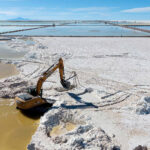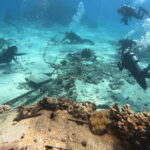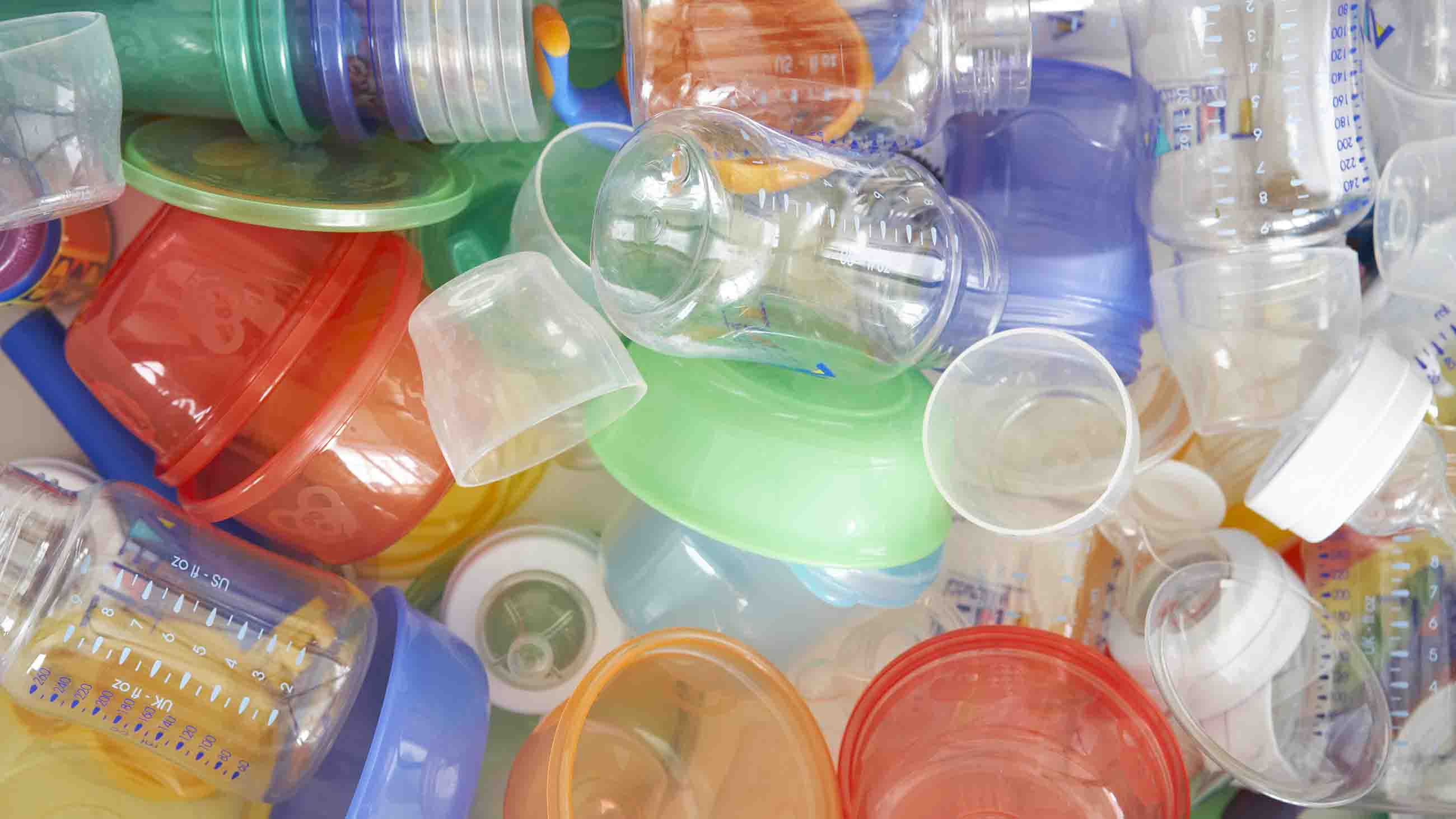The Pros and Cons of ‘BPA-Free’
Five years ago, the U.S. Food and Drug Administration officially banned the use of the chemical bisphenol A — commonly referred to as BPA — in plastic baby bottles and sippy cups. A year later, the agency extended the ban to the chemical’s use in baby formula packaging. Manufacturers had used BPA for decades, but modern research in animal models and human cell cultures suggested that the estrogen-like chemical can leach from containers to food and, particularly in infants, potentially affect prostate and brain function.
The FDA did not ban the use of BPA in other products, and its uses have historically been ubiquitous: The chemical can be found in the liners of food cans and bottle tops, plastic water bottles, eyeglass lenses, safety equipment, dental sealants, water supply lines — even some thermal papers used in retail store receipts have BPA-based coatings. As it currently stands, federal regulators consider all of these products and the small levels of exposure associated with BPA leaching to be safe, although research is ongoing.
Manufacturers themselves had sought the initial FDA ban in baby items in the hopes that it would protect the industry and shore up consumer confidence. But the damage to BPA’s reputation was done. California’s decision three years later to add BPA to its inventory of chemicals known to cause reproductive toxicity didn’t help — and to date, more than a dozen states have passed laws banning or restricting BPA’s use in a variety of products.
In response, the manufacturers have been racing to deploy alternatives and push “BPA-free” consumer products onto the market — but if that sounds like a good thing, there’s a problem: The substitute chemicals, including common alternatives like bisphenol S (BPS) or bisphenol F (BPF), are similar chemicals and, scientists suggest, are likely to have analogous effects on health. In practical terms, this suggests that a “BPA-free” label might be of little consequence to a consumer concerned about the potential impacts of exposure. Some of the alternatives to BPA that industry is using “could be as bad, if not worse in terms of their estrogenic capabilities,” said Michael Antoniou, a molecular geneticist at King’s College London. “There needs to be some caution here.”
Manufacturers describe BPA as an exceptional industrial chemical. It is used to make plastics hard and clear and durable, and it has proved useful as the basis for resins that protect canned foods from coming in direct contact with metal, which prevents corrosion and preserves flavor. “These unique attributes,” the Polycarbonate/BPA Global Group, an industry organization, notes on its website, “provide high-performance benefits in a wide array of consumer and industrial products that perform well in harsh settings.”
Still, BPA is a synthetic estrogen and it mimics the female sex hormone. As a result, studies have suggested that depending on the dose, the chemical can interfere with the signals hormones carry, disrupting the body’s communication networks in glands of the endocrine system, affecting the reproductive, brain, and immune systems. In its most recent assessment, the FDA concluded that “an adequate margin of safety exists for BPA at current levels of exposure from food contact uses.” But that has done little to slow the rapid transition to BPA-free products, and scientists have been scrambling to understand the chemical’s replacements.
Antoniou’s new study in Toxicological Sciences used human breast cancer cell lines to compare seven bisphenols used in the industry, finding that they all had some level of estrogenic activity and three had more than BPA. In other recent studies, BPS, a common substitute and one that public health advocates describe as “regrettable,” has been shown to have similar adverse health effects in tests of both lab rats and zebrafish.
That doesn’t strike some experts as much of a surprise, given that the chemical structure of BPA and BPS are nearly identical. Indeed, the structure of all bisphenols resemble a pair of spectacles with benzene lenses. “I find it hard to believe that the chemical industry and manufacturers using these chemicals didn’t think about this,” said Nancy Wayne, a reproductive neuroendocrinologist at UCLA. “What made them think that BPS would be safer?”
Most plastic containers release these chemicals, usually in just trace amounts, although they leach a bit more when heated, such as in a microwave. Concentrations of just one part per trillion of a harmful chemical are hard to find in the blood, and it’s difficult to test directly whether it has a health effect. Of course, cumulative effects over time are a bigger concern, and complicating things further: While lower does often mean lower responses for many chemicals, bisphenols don’t act that way. Here, small exposures can potentially be more dangerous than larger ones. That means BPA studies that give lab animals high doses might actually be less relevant to humans, who are typically exposed to very low concentrations.
This might all prove inconclusive enough for many consumers to feel comfortable with BPA and its substitutes, but for those looking to avoid the bisphenol family altogether, options — and information — are often limited. Ruthann Rudel, a toxicologist and director of research at the Silent Spring Institute, a nonprofit public health research group in Newton Massachusetts, just completed a crowdsourced study analysis in which participants sent in their own urine samples for testing. “The people in our study did have lower [BPA] exposure,” she noted, “but their exposures to the two substitutes [BPS and BPF] are higher.”
Rudel speculated that this was because the participants were choosing BPA-free products.
While food and beverage industry heavyweights like General Mills, Campbell’s, and Del Monte don’t acknowledge that BPA may be unsafe, they have responded to consumer demand and are gradually shifting to BPA-free lined cans and products. In response to queries from Undark, General Mills and Campbell’s both said that they put their new chemicals through “extensive” and “rigorous” testing. But none of the major companies reveal precisely what chemicals they use.
Other companies catering to more environmentally-minded consumers, including sports-bottle makers Nalgene and Camelbak, use a completely different material called Tritan, which is free of BPA, BPS and BPF. Many baby bottle manufacturers use Tritan as well, and a Nalgene representative said that their bottles are “tested and certified estrogenic activity-free.”
Eastman Chemical, the maker of Tritan, has fiercely defended that assertion in court, successfully suing to quash claims to the contrary by a University of Texas neurobiologist and entrepreneur exploring non-estrogenic plastics, though discussion of this and other bisphenol substitutes continue.
The murkiness is partly why groups like Breast Cancer Prevention Partners advocate for an independent, third-party assessment known as GreenScreen for Safer Chemicals. Major companies in other industries, like Hewlett-Packard and Nike, have already participated in the program — developed by the Massachusetts-based group Clean Production Action — which seeks to identify chemicals of high concern in consumer products. “We want companies to be transparent about what they’re using, what safety tests they’ve done and what the health effects may or may not be,” said Sharima Rasanayagam, director of science at Breast Cancer Prevention Partners.
For now, that remains mostly wishful thinking.
In the ongoing effort to understand the chemicals used in plastics and their potential impacts on public health, the FDA and the National Toxicology Program, an inter-agency program run by the United States Department of Health and Human Services, are conducting a long-term feeding study in rodents, the results of which will be available early next year. But thus far they have only investigated BPA, not its substitutes.
The state of California’s environmental health office also says that they aren’t currently considering adding any BPA alternatives to their list of harmful chemicals, though they don’t know all chemicals being used as BPA substitutes.
“We’ve gotten comfortable with plastics,” said Deborah Kurrasch, a medical geneticist at the University of Calgary. It’s going to be hard to get plastics that are cheap, clear, odorless and lightweight and all the things we want out of them — but not leach, she said. “That’s going to be a tall order. At some point society needs to have a conversation about what we’re willing to tolerate.”
Ramin Skibba is an astrophysicist turned science writer and freelance journalist who is based in San Diego. He has written for Newsweek, Slate, Scientific American, Nature, Science, among other publications. He can be reached on Twitter at @raminskibba.
CORRECTION: An earlier version of this piece incorrectly listed Ruthann Rudel as leader of the Silent Spring Institute. She is the director of research.











Comments are automatically closed one year after article publication. Archived comments are below.
If these chemicals are such concern then why on earth are they still being used at all? Is there not safer alternatives? And, why wouldn’t we know about chemical cans in top brands everyone uses every day? Unbelievable.